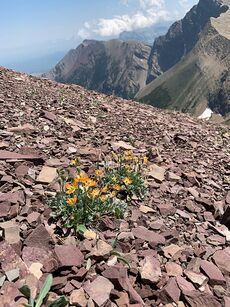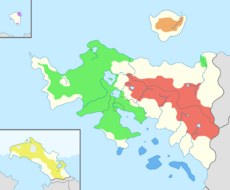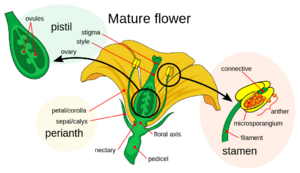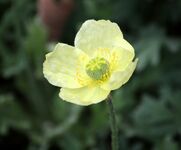Huelrosa
| Huelrosa | |

| |
| Bundle of highlands poppies near Mt. Baghdad | |
| Most at risk | |
| Huelrosa insulaaureus É.Dubois, 1552 AN | |

| |
| Vulnerable (MUNHC) | |
| Scientific classification | |
| Kingdom: | Plantae |
| Clade: | Tracheophytes |
| Clade: | Angiosperms |
| Clade: | Eudicots |
| Order: | Ranunculales |
| Family: | Papaveraceae |
| Subfamily: | Papaveroideae |
| Tribe: | Papavereae |
| Genus: | Huelrosa É.Dubois, 1552 AN |
| Type species | |
| Huelrosa borealis B.Frost, 1498 AN | |

| |
| Huelrosa ranges: Frost; Highlands; Island golden; Mt. James; Nectar-of-the-north; Treynor | |
| Species | |
| |
Huelrosa, commonly known as the Meckelnish poppies, is a six-species genus of cold-hardy boreal flowering plants exclusive to the territories of the Kingdom of Meckelnburgh and neighboring frontier lands. It belongs to the poppy family, Papaveraceae, and is classified under the subfamily Papaveroideae, along with several other genera of the poppy flower—including Huelrosa's cousin genus Papaver, the type genus of the poppy family. The genus holds significant cultural import in Meckelnburgh, where the highlands poppy, Huelrosa montana, is the national flower.
Distribution
The distribution of Huelrosa is restricted to Meckelnburgh proper, Salem and Iselande, as well as adjoining sections of bordering nations. It is native within its entire range. Huelrosa is distributed in all through:
- Genevelond Peninsula
- Treynor Archipelago
- Glanurchy Island
- Fifty Elk Island
- Jääland Peninsula
As hardy perennials, Huelrosa plants are well-suited to the climate of Meckelnburgh, contributing to their reproductive success. It can be found in various habitats such as rocky mountain outcrops, insular meadow fields, and polar glaciers. The genus has adapted to different ecological niches within its range, showcasing six diverse species.
Description
In the Huelrosa genus, the flowers display distinctive features, consisting of two sepals that shed as the bud unfurls. The Huelrosa flower showcases four to six petals, exhibiting a diverse range of colors, including orange, yellow, white and cream. The reproductive structure comprises multiple stamens arranged in several whorls encircling a compound pistil, formed through carpel fusion. The number of stigmas visible atop the capsule corresponds to the fused carpels.
As Huelrosa reaches maturity, the ovary undergoes a transformation, developing into a dehiscing capsule that becomes capped by dried stigmas. Subsequently, the opened capsule disperses its numerous tiny seeds through air movement, facilitated by its long stem.
In the typical Huelrosa gynoecium, the ovary is positioned superiorly, resulting in a hypogynous flower with a globular shape. The sessile plate-like stigmata rests atop the ovary, providing pollen-receptive surfaces. The prevailing fruit type in the Huelrosa genus is the unilocular capsule. Positioned on top of the capsule is the stigmatic disc, beneath which dehiscent pores or valves facilitate seed dispersal.
While sometimes mistakenly labeled as biennials, the Huelrosa genus is perennial and its plants will last three seasons or more in the proper soil and lighting conditions. The plants require well-drained soils and partial to full sun. Huelrosa grow from 9 to 60 cm in height, and their attractive flowers serve as a resource for pollinators like bees and butterflies.
Species
Frost poppy
Huelrosa borealis — arctic poppy, frost poppy, ice poppy, B.Frost, 1498 AN
The frost poppy is found in the warmer lowland regions of Meckelnburgh, though adapted to the common snowy conditions. It is the most common Huelrosa, and is found throughout the Koranga Plains of the Cumberland province in western Meckelnburgh, down through the capital Alexandretta and onto the Siegrwang Peninsular in the south. The stems of H. borealis grow upwards of 30–60 cm in height, with hairy stems. Its petals appear yellow or soft white, hence the namesake of "frost." The frost poppy prefers meadowlands and open plains.
H. borealis is a popular species in Meckelnburgh used for aesthetic and competitive cultivars. As the most fragrant, it is common within homes and gardens. Cultivars are commonly bred for orange, pink and red petals. H. b. subsp. orientalis carries many of the recessive genes necessary for breeding these varieties.
Eastern frost poppy
Huelrosa borealis subsp. orientalis — eastern frost poppy, E.Janssen, 1594 AN
The eastern frost poppy is found along the lower River Tscheid in eastern Meckelnburgh, in the Brittnay province. The yellow blooms of H. b. subsp. orientalis were thought to be a separate species until the 1590s AN. While capable of interbreeding, it is slightly smaller in size, reaching 25–45 centimeters with smooth stems. The eastern frost poppy's range is nonetheless far distant from its nominotypical relations.
Highlands poppy
Huelrosa montana — highlands poppy, B.Helgason, 1605 AN
The highlands poppy is native to the rocky highlands and mountain slopes in Meckelnburgh, with its range throughout the Comstokia Mountains of central and east-central Meckelnburgh. H. montana is most commonly found in areas above 500 meters in elevation. It thrives better on the southern slopes of the Comstokias, in The Clanlands province, where more temperate continental and ocean-moderated rains provide a more forgiving climate.
The stems of the highlands poppy are the shortest, only 9–15 cm. Its petals are brightly bicolored, appearing orange at the tips and blending to yellow by the pistil. H. montana thrives in rocky soils prevalent in the alpine regions, often found on steep slopes and rocky outcrops.
The highlands poppy is also the national flower of Meckelnburgh. No cultivars are known as the flower is intended to be preserved like its wild form.
Island golden poppy
Huelrosa insulaaureus — island golden poppy, É.Dubois, 1552 AN
The island golden poppy is the rarest of Huelrosa species, found only on Fifty Elk Island in the Prince-Archabbacy of Salem, off the coast of Lac Glacei in the Northern Sea. The stems of H. insulaalba reach a height of 30–40 cm, with petals of vivid yellow. The island golden poppy thrives in the wetlands of the island.
Mt. James poppy
Huelrosa volcana — Mt. James poppy, volcano poppy, E.Janssen, 1589 AN
The Mt. James poppy occurs on Mt. James, a semi-active volcano in Meckelnburgh, which is the source of Glanurchy Island in the Palatinate of Hergilsey. H. volcana thrives in volcanic soils and can be found on the rocky slopes of Mt. James, in and about the ice-free portions of the volcano's slopes.
The stems of the Mt. James poppy reach a height of 12–18 cm, with flowers that show in buff cream or yellow-green. H. volcana is adapted to the extreme temperature variations possible across Glanurchy Island. The Mt. James poppy is also heliotropic, growing to face the direction of sunlight.
Nectar-of-the-north poppy
Huelrosa polarnectaris — nectar-of-the-north poppy, T.Järvinen, 1610 AN
The nectar-of-the-north poppy is the most northernmost of Huelrosa and is native to the polar regions of the Grand Duchy of Iselande, primarily on the permanent tundra and glaciers in the north of the Jääland Peninsula. The stems of H. polarnectaris grow to 15–35 cm in height while its petals appear pale white to a light lime green. The nectar-of-the-north poppy thrives on the tundra and around glaciers, often found in areas with permafrost.
Treynor poppy
Huelrosa archipelagica — Treynor poppy, A.Helgason, 1608 AN
The Treynor poppy is native to the Treynor Archipelago, lying in the south of Meckelnburgh in Crowsilver Bay, on the edge of Tallandor Bay. Its range has also been known to extend in small blooms around the city of Victoria on the Siegrwang Peninsular. The stems of H. archipelagica have a height of 10–25 cm and its petals appear yellow to lime green. The Treynor poppy thrives in sandy, gravel, and clay soils along coastal headlands and hillsides throughout the archipelago.
Conservation
Due to its wide distribution, Huelrosa faces mild conservation challenges, but is nonetheless affected by human activities, including habitat destruction from logging or other resource-extraction industries, particularly the highlands poppy in the Comstokia Mountains. The rarest, the island golden poppy, lives in a narrow habitat on Fifty Elk Island, facing intrusion by the expanding built environment of the monasteries under the archabbacy of Salem.
Huelrosa is nonetheless protected in the royal preserves, forests and other conservation areas throughout Meckelnburgh.
History & uses
Poppies have a rich and ancient history, with evidence of their cultivation as ornamental plants dating back to 5000 BC in Mesopotamia. These vibrant flowers have also been discovered in Egyptian tombs. In Greek mythology, the poppy held significance as it was associated with Demeter, the goddess of fertility and agriculture. Notably, the cultural symbol's origin can be traced back to Minoan Crete, as suggested by the discovery of a figurine known as the "poppy goddess" in a Minoan sanctuary on the island.
Throughout history, poppies have been highly regarded for their medicinal properties. The stems of many poppy species contain a milky latex that can cause skin irritation. In particular, the opium poppy (Papaver somniferum) yields a latex rich in narcotic alkaloids, such as morphine and codeine. The corn poppy (Papaver rhoeas) contributes the alkaloid rhoeadine, known for its mild sedative properties. Poppy seeds find culinary use, added to various baked goods and dishes, while poppyseed oil is employed in cooking and pharmaceuticals, as well as acting as a radiocontrast agent.
Ancient Greek mythology associated poppies with the gods of sleep, night, and death, represented by Hypnos, Nyx, and Thanatos, respectively. Historical accounts indicate that the plant might have been used for euthanasia on certain Greek islands, with women employing it in old age to shorten the time until natural death. The influential physician Hippocrates (460–377 BC) recognized the medicinal value of poppies, describing poppy juice as narcotic, hypnotic, and cathartic, and even considering its use as food, especially the seeds. By the first century AD, Dioskorides compiled the first taxonomy of poppies, distinguishing between various species and types with different properties. Pliny the Elder, a Roman historian, later wrote about the medical applications of poppy products, including opium, which was used to promote sleep and treat respiratory problems.
In the 19th century, poppy seed oil gained importance as a food crop, with large-scale production coinciding with Europe's manufacture of morphine. The First (1839–1842) and Second Opium Wars (1856–1860) between China and Great Britain arose from conflicts over opium imports into China. Today, morphine and codeine, derived from poppy alkaloids, play significant roles as drugs worldwide. Australia, Turkey, and India serve as major producers of poppies for medicinal purposes, while the US, the UK, France, Australia, and Hungary are prominent processors.
In the United States, opium is illegal, although poppies are often grown for culinary or ornamental purposes without strict enforcement of the law. The Opium Poppy Control Act of 1942 led to the "Poppy Rebellion," a clash between California farmers and the federal government. Even today, the law and its enforcement remain contentious, sometimes sparking disputes between gardeners and authorities.
Presently, poppies are not only used for their medicinal properties but also sold as cut flowers, with the Iceland poppy being a popular choice in flower arrangements.
Apart from their ecological importance, Huelrosa flowers hold cultural significance in Meckelnburgh, often featuring in traditional festivals and ceremonies, symbolizing beauty, resilience, and the nation's natural heritage. The highlands poppy, H. montana, is the national flower of Meckelnburgh, and adorns countless gardens and ceremonies kingdom-wide. Artists and poets draw inspiration from these blooms, further highlighting their role in the country's cultural identity.
Toxicity
Huelrosa plants are poisonous to humans, which is similar to all poppies. These toxic properties can be attributed to the presence of alkaloids in the plant's composition. Notably, Huelrosa has been found to contain the benzophenanthidine alkaloid, chelidonine, which contributes to its toxic nature. Injection of Huelrosa may result in ptosis tremor, sedation and a drop in body temperature. Other alkaloids have also been measured in Huelrosa.







